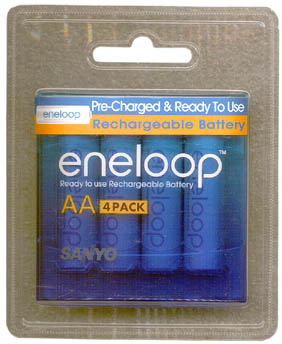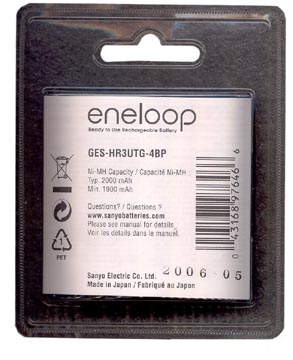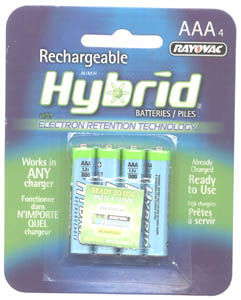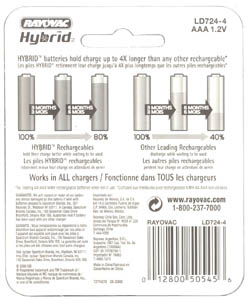Ready to use Rechargeable Battery
eneloop by Sanyo
© Brooke Clarke 2007 |
 |
| Four pack eneloop Ni-MH batteries |
Label |
 |
 |
| Four pack eneloop Ni-MH batteries |
Label |
| Chemistry |
% / month |
| Ni-MH |
30 |
| Ni-Cad |
15 to 20 |
| Li-xx |
2 to 3 |
| Ready to Use Ni-MH |
1.5 |
| Lead Acid |
1.4 |
| Year |
% / 6 mo |
% / mo |
| 1901 |
35 |
6.9 |
| 1916 |
25 |
4.7 |
| 1934 |
7 |
1.2 |
| 1951 |
2 |
0.3 |
 |
 |
| Rayovac Ready To Use AAA batteries 4 pack |
|
| ID |
A1 |
A2 |
A3 |
A4 |
B1 |
B2 |
B3 |
B4 |
| Capacity as received |
6441 |
5951 |
6192 |
6212 |
6072 405 |
6092 412 |
6122 408 |
6082 406 |
| Capacity at different rates |
7823 260 min |
7713 259 min |
7364 122 min |
7824 130 min |
na |
na |
na |
na |
| Capacity after Break-in 5 |
797 |
782 |
770 |
800 |
785 326 |
771 322 |
775 320 |
774 323 |
| Working mAh Capaacity6 min |
785 524 |
766 517 |
780 518 |
786 524 |
| 1 |
2 |
3 |
4 |
|
| Tmin |
9 |
10 |
9 |
8 |
| Volts now |
1.2 |
1.2 |
1.2 |
1.2 |
| mAh |
128 |
133 |
137 |
126 |
| 1 |
2 |
3 |
4 |
|
| Tmin | 106 |
110 |
113 |
109 |
| Volts now | 1.44 |
1.45 |
1.44 |
1.44 |
| mAh | 1607 |
1660 |
1709 |
1650 |
| 1 |
2 |
3 |
4 |
|
| Tmin |
170 |
166 |
169 |
165 |
| Volts now |
1.41 |
1.41 |
1.41 |
1.41 |
| mAh |
1284 |
1242 |
1276 |
1238 |
| na |
na |
na |
na |
|
| Tmin |
273 |
316 |
281 |
315 |
| Volts now |
1.41 |
1.43 |
1.40 |
1.43 |
| mAh |
1317 |
1508 |
1359 |
1511 |
| 1 |
2 |
3 |
4 |
|
| Brand |
Sanyo |
Maha |
China |
Kodak |
| C mAh |
2000 |
2700 |
1800 |
1600 |
| Discharge |
200 |
200 |
200 |
200 |
| 10pm 7nov07 Capacity B#1 |
1798 |
1816 |
1247 |
1460 |
| 10am 8 Nov07 Capacity B#2? | 1927 |
2131 |
1715 |
|
| 10am 9Nov07 DisCap B#2 | 1759 |
2419 |
1194 |
1414 |
| 1am 11Nov07 DisCap B#3 | 1743 |
2414 |
1187 |
1204 |
| Capacity B#4 | 1720 |
2382 |
1128 |
1217 |
| mAh |
e1 |
e2 |
e3 |
e4 |
P1 |
P2 |
P3 |
P4 |
K1 |
K2 |
K3 |
K4 |
C1 |
C2 |
C3 |
C4 |
| NiM |
NiM | NiM | NiM | NiM | NiM | NiM | NiM | NiM | NiM | NiM | NiM | NiC |
NiC | NiC | NiC | |
| Rating |
2000 |
2000 | 2000 | 2000 | 2700 |
2700 | 2700 | 2700 | 1600 |
1600 | 1600 | 1600 | 1800 |
1800 | 1800 | 1800 |
| Note 1 |
1607 |
1660 |
1709 |
1650 |
2597 |
2588 |
2595 |
2607 |
1317 |
1508 |
1359 |
1511 |
1284 |
1282 |
1276 |
1238 |
| 7-12Nov07 | 1798 |
1927 |
1743 |
1720 |
1816 |
2419 |
2414 |
2382 |
1460 |
1715 |
1204 |
1217 |
na |
1194 |
1187 |
1128 |
| 13-18 Nov07 |
1923 |
1802 |
1793 |
1783 |
2541 |
2398 |
2375 |
2381 |
1414 |
1349 |
1175 |
1194 |
1331 |
1221 |
1213 |
err3 |
| 18 -20Nov07 |
1848 |
1812 |
1831 |
1827 |
2395 |
19493 |
2427 |
2440 |
1329 |
1340 |
1192 |
1209 |
1216 |
1224 |
err3 |
1274 |
| 20-23Nov074 |
1898 |
1838 |
1854 |
1853 |
2444 |
2421 |
2449 |
2463 |
1346 |
1371 |
1182 |
1212 |
1271 |
1228 |
err |
1243 |
| 23- |
1889 |
1849 |
1850 |
1838 |
2454 |
2428 |
2448 |
2453 |
1316 |
1360 |
1174 |
1204 |
err |
1217 |
1218 |
1220 |
| Average (last 2) |
1894 |
1844 |
1852 |
1845 |
2449 |
2425 |
2449 |
2458 |
1331 |
1366 |
1178 |
1208 |
1271 |
1223 |
1218 |
1232 |
| R |
9 |
11 |
4 |
15 |
10 |
3 |
1 |
5 |
15 |
6 |
4 |
4 |
na |
11 |
na |
12 |
| Date |
Weeks |
mAh e |
mAh P |
mAh K |
mAh C |
| 21 Dec 2007 e1, P1, K1, C1 |
4 |
1761 93% |
2253 92% |
1169 88% |
1050 83% |
| 18 Jan 2008 e2, P2, K2, C2 | 8 |
1694 92% |
2158 89% |
1161 85% |
970 79% |
| 15 Feb 2008 e3, P3, K3, C3 | 12 |
1667 90% |
2112 86% |
784 67% 2 |
921 76% |
| 14 Mar 2008 e4, P4, K4, C4 | 16 |
1646 89% |
2087 85% |
990 82% |
848 69% |
| 9 May 2008 e1, P1, K1, C1 | 201 |
1698 89% |
2048 84% |
1066 80% |
847 67% |
| 6 June 2008 e2, P2, K2, C2 | 24 |
-3- |
-3- | -3- | -3- |
| 4 July 2008 e3, P3, K3, C3 | 28 |
-3- | -3- | -3- | -3- |
| 1 Aug 2008 e4, P4, K4, C4 | 32 |
-3- | -3- | -3- | -3- |
| 26 Sep 2008 e2, P2, K2, C2 -something wrong this date- |
40 |
718 39% |
494 20% |
718 53% |
457 38% |
| 12 Nov 2008 -4- e3, P3, K3, C3 |
46.5 |
1581 85% |
1739 71% |
0 dead |
361 30% |
| 21 Nov 2008 |
48 |
| I1 |
I2 |
I3 |
I4 | P5 |
P6 |
P7 |
P8 |
|
| 500 ma disC. (as received) | na |
na |
na |
na |
41 |
49 | 49 |
41 |
| Break-In | 2099 |
2122 |
2070 |
2142 | 2541 |
2570 | 2562 |
2617 |
| 500 ma disC. |
2104 |
2134 |
2091 |
2160 | 2532 |
2550 |
2547 |
2607 |
| C401 chg -> 500 ma disC. |
2033 |
2137 |
2097 |
2101 | 2474 |
2500 |
2494 |
2552 |
| C401 chg -> 500 ma disC. | 2071 |
2116 |
2107 |
2121 | 2480 |
2493 |
2489 |
2544 |
| C401 chg -> 500 ma disC. | 2063 |
2135 |
2060 |
2160 | 2486 |
2507 |
2497 |
2552 |
| 15 Dec = 4 weeks I1 |
x |
x |
x | x |
x |
x |
x |
|
| 20 Dec = 4 weeks |
x |
x |
x |
x |
x |
x |
x |
[an error occurred while processing this directive] page created Oct 18, 2007.